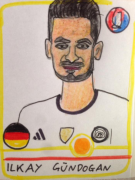|
twoday posted:This looks great. Did you find that link as a reference somewhere? I know a little bit of Italian and I would like to try reading it but I don't feel like tracking down a book from 1892. The Internet Archive has the full volume digitised. The Azores article begins on p. 529
|
|
|
|

|
| # ? May 23, 2024 14:58 |
|
Excellent.
|
|
|
|
twoday posted:This looks great. Did you find that link as a reference somewhere? I know a little bit of Italian and I would like to try reading it but I don't feel like tracking down a book from 1892. It is listed in passing on the Wikipedia page about the History of the Azores, which includes some additional discussion about other "pre-discovery" maps. quote:The Azores archipelago began to appear on portolan charts during the 14th century, well before its official discovery date. The first map to depict the Azores was the Medici Atlas (1351). Its depiction was subsequently replicated in the Pizzigani brothers map of 1367, the Catalan Atlas (1375), the Pinelli–Walckenaer Atlas (1384), the Corbitis Atlas (c. 1385–1410), the charts of Guillem Soler (1380, 1385), Mecia de Viladestes (1413) and others. They are also listed in the Libro del Conoscimiento (c. 1380). ComradeCosmobot fucked around with this message at 01:02 on Sep 9, 2016 |
|
|
|
Squalid posted:Looking briefly at that guy's research on megaliths it seems there's uh a bit of stretching going on, some of those "megaliths" look remarkably like regular ol' rocks. Some photos in that article:    They are at least accompanied by detailed descriptions of the way the stones at these sites were positioned, and the positions and angles of the stones to each other, and what sorts of passageways and chambers they formed. I also am inclined to say that they do remind me of the neolithic sites in the Netherlands which I have visited. We have one area (Drenthe) which is covered with hundreds of small bona-fide megalithic structures, and many of them aren't very impressive until you start thinking about how the rocks ended up where they are, and how these structures must have looked earlier. Not everything from that time looks like Stonehenge. The best sites in Drenthe look like this:  But many others look just like piles of rocks at first glance:   They were originally surrounded by dirt mounds that made their cavities into chambers:  This guy's written descriptions seem reminiscent of this sort of thing, and I would say the photos I posted from the article here, while terribly photographed, seem reminiscent of other minor neolithic structures like those in Drenthe and all over continental Europe. [quote] Stone walls, at left and right sides, with 1.5 m height, made of worked block stones, support big stones (with more than 2 tons) with an inclination of 57˚. At the ceiling, three big stones form a pyramided end shape, which are physically important for the structure’s equilibrium. The corridor ends in a kind of circular burial chamber, with 2.5 m larger and 1.5 m height. The opening orientation of this corridor is to the North.[/url] Phlegmish posted:Yeah, I had the same thought when looking at those 'pyramids'. I feel like if the Azores had been colonized long enough for that kind of structure to be built, there would be other, more conclusive signs of a human presence. What? These Azorean pyramids? -%5B78431%5D_res.jpg)   These Azorean pyramids which bear a remarkable resemblance to ancient structures on the Canary Islands (which are known to have been populated since ancient time)such as this one?  I'm obviously playing devil's advocate here, but if you think that these structures were produced since the arrival of the Portuguese in the 15th century, I'd like to hear an explanation for why the Portuguese colonists would have built dozens of these structures. And as for more conclusive signs of a human presence, I will share some vacation photos from the last time I was there to point out the islands are littered with abandoned structures in various states of decay  (this one obviously quite recent) and signs of human development are to be seen all over the islands, often in the form of high walls   but nearly everything there, regardless of its age, looks more or less the same because everything is built out of stacks of volcanic rocks, often without mortar, and it is difficult to say when many of these structures were built. If one of these walls was first built a thousand years ago and was later restored by a Portuguese settler it would be nearly impossible to tell now. So perhaps there are many signs of early human presence that have been integrated into the current landscape. If there was supporting evidence of ancient settlement besides the pyramids, it might be hard to spot now because it may have been camouflaged since. Also, I heard back from the guy who wrote the articles. He said some interesting things, but I found amusing was that he said that he had a hard time accessing many of the "pyramidal" structures because they were enclosed by fences on property that was either abandoned or where the owner was not home, and that he was afraid of trespassing because there might be dogs around. I can confirm that horrifying dogs are ubiquitous on the islands.  Sorry for hijacking the thread with this. 
|
|
|
|
Squalid posted:If there had been an early colonization and subsequent isolation you'd expect to see some genetic evidence among the populations of human mutualists or odd accounts from the first recorded visitors of abundant goats or sheep. quote:possibly of Andalusian Arab origin e.g. al-Idrisi speaks of an Atlantic island of wild goats twoday fucked around with this message at 02:41 on Sep 9, 2016 |
|
|
|
I mean if you squint and use a bit of imagination those things are plausibly megaliths, might be easier to tell if his photos were from non-ridiculous angles or he had sketched out the site so you could get a better idea of what's going on. but I was thinking especially of this example of "rock art"  Come on man that's some weak poo poo. At most it looks like someone used it as an anvil or something. You'd have to squint so hard your eyes close to see the supposed engraving of a boat he has in another picture. Just compare his so-called cup-marks to examples from the continent or rock art in the Canaries, the difference is dramatic. One begins to wonder if he's mixing up natural caves, ejecta, recent structures and volcanic formations with evidence for ancient settlement. Oh and his article is published in an obvious pay-to-play junk journal. Vaguely speaking of an island of goats doesn't mean anything, lots of islands have goats. I did a cursory search for the first-hand accounts and while I couldn't find any of the discovery of the islands (I am not a historian, btw) I found a few brief descriptions on wikipedia referring to Portuguese language sources. They usually mentioned the first explorer or settler releasing cattle or sheep or other animals onto the islands prior to or at settlement, because they weren't there. If the first account of an island includes reference to abundant cattle or something that would be strong evidence at least for pre-discovery use of the island by fishermen, not something I know anything about though. However If you do want biological evidence for early explorers in the Atlantic http://onlinelibrary.wiley.com.proxy.library.msstate.edu/doi/10.1111/jeb.12550/full The author of this article believes the genome of mice in Madeira is indicates a Northern European origin, and is very convinced they were brought by the vikings. Which is a cool theory.
|
|
|
|
twoday posted:What? These Azorean pyramids? Given the size of those structures, they would have each required significant time (i.e. more than a few days) and workforce (i.e. several dozen men). This means there would be camps with according traces of settlement on the Azores near these structures, and finding things appropriate for a given era would be relatively uncommon : pottery fragments, rope, leather, silex shards, tools... Each of these could be pretty easily analysed to narrow down the possible date during which the settlement was established. Beyond that, these camps would have most likely contributed to spreading cultivars and livestock species from either neighboring islands or the origin locale of the journey. As such, it would be surprising for one island to have goats, another rabbits (to such an extent that these are considered exceptional enough to name the island after them) and yet these animals not have been spread throughout the Azores by the population that built these structures. Without being a specialist on these structures, wouldn't it be possible that they are simply low-cost watchtowers or lighthouses? These could have been built by the Portuguese settlers as they lacked mortar and other materials to make taller structures with less "footprint", either including those on the Canary islands or as an imitation of them.
|
|
|
|
Shazback posted:Given the size of those structures, they would have each required significant time (i.e. more than a few days) and workforce (i.e. several dozen men). This means there would be camps with according traces of settlement on the Azores near these structures, and finding things appropriate for a given era would be relatively uncommon : pottery fragments, rope, leather, silex shards, tools... Each of these could be pretty easily analysed to narrow down the possible date during which the settlement was established. According to UNESCO, these pyramids are deposits of volcanic rock commonly created near villages as settlers cleared land for farming, and that this cultural practice is documented continuing til the 19th century.
|
|
|
|
The more you know ™
|
|
|
|
Ratpick posted:A stupid map, but here you go: I know this is a literal translation of nation names in Chinese but I'm sure this could also function as a country name generator for the writer of a children's cartoon.
|
|
|
|
Is there a source that can explain the rationale for these names? I really need to know how, among other things, Bulgaria becomes Insurance + Profit Ya or Portugal is Grapetooth.
|
|
|
|
Titus Sardonicus posted:Is there a source that can explain the rationale for these names? I really need to know how, among other things, Bulgaria becomes Insurance + Profit Ya or Portugal is Grapetooth. Almost all of them are just using Chinese characters to approximate the name of the country as it's spoken.
|
|
|
|
Titus Sardonicus posted:Is there a source that can explain the rationale for these names? I really need to know how, among other things, Bulgaria becomes Insurance + Profit Ya or Portugal is Grapetooth. quote:The inconsistencies you pointed out are due to the fact that the countries mentioned–England, Germany and France (along with the U.S., by the way)–were the nations that almost split up China during the height of European imperialism in the late 19th century. As a result, when the Chinese were modernizing the Mandarin language wholesale sometime in the early 20th century, they were less concerned with phonetic spelling and more with double-meaning when naming these powerful nations they badly sought to emulate (or so that’s my take on why the names came out as they did). More discussion here: https://haonowshaokao.com/2013/04/25/chinese-map-of-europe/
|
|
|
|

|
|
|
|
mcustic posted:More discussion here: You would think that being an authoritarian state that China could instead force everyone to use a sensible writing system based on sounds that allowed them to do simple tasks like add new words. Korea did it, Japan kinda did it (Though they kept the old way too) so it's not like they don't know exactly how they could get it done.
|
|
|
|
galagazombie posted:You would think that being an authoritarian state that China could instead force everyone to use a sensible writing system based on sounds that allowed them to do simple tasks like add new words. Korea did it, Japan kinda did it (Though they kept the old way too) so it's not like they don't know exactly how they could get it done. I don't know what to tell you if you think Korean and Japanese can write sounds outside their language with their writing system. Korean may have an alphabet but the rules mean it garbles foreign words just as badly as Chinese does. Sprite in Korean turns into Seupeuraiteu, five syllables.
|
|
|
|
Why would they not keep the colours steady for this gif? It's actually very difficult to see what's changing when the colours are changing every time. mcustic posted:More discussion here: And here I love it that all those countries get detailed names and Russia is just Russia.
|
|
|
|
Grand Fromage posted:I don't know what to tell you if you think Korean and Japanese can write sounds outside their language with their writing system. Korean may have an alphabet but the rules mean it garbles foreign words just as badly as Chinese does. Sprite in Korean turns into Seupeuraiteu, five syllables. Latin isn't too good at adding sounds not native to Rome either, but it still, like korean and japanese, uses a sound-letter correspondence instead of sound-meaning like chinese. Latin mangles chinese pretty badly because the tones are not represented for example. Arabic ع frequently gets left out because it's weird too.
|
|
|
|
The difference is we're willing to learn to pronounce things differently. English speakers learn that when you have a Spanish loanword like tortilla, the ll is pronounced as a y. Korean absolutely refuses to make any accommodation in its rules for loanwords and I don't believe Japanese does either but I don't speak it.
|
|
|
|
I think you're kinda overstating it there on both counts. Tortilla (and Spanish words in general) are kinda an exception. If you take a look at how we pronounce most Asian words in English (taekwondo, hyundai, seoul, karaoke, tokyo) it's about as different as most Koreanized-English words are from the actual English (and I'm assuming the same is true of Japanese). I mean your sprite example for instance, yeah it's written 스프라이트 in five discrete syllables but the way they say it is more like speu-ri-teu in three. Even getting to French, English speakers usually don't pronounce stuff remotely how it is in the actual language. For an eastern European language fat loving chance. I think you have experience with generally much more worldly Americans than the norm, most people aren't really willing to engage with this stuff unless it's something like a tortilla that has a funny rule that's simple to memorize. And even then we still all say llama with a distinct l, at that. e: I do agree that the latin alphabet is way more accommodating in this regard than hangeul and presumably the Japanese ones, but I don't think we're especially less pig-headed as English speakers about loan words than people in most other people in the world. An absolutely huge chunk of Korean vocabulary is Koreanized english, they're not remotely uptight about keeping the language unique or whatever.
|
|
|
|
I was always curious where you lived in Korea, your experiences have been somewhat different than mine but I didn't live in Seoul. I never heard anyone say Sprite like that. It's not like they pause between each syllable but they're distinct--my region was Gyeongsang accent, though. Llama is an example of the change, since English used to Anglicize the pronunciations a lot more than it does now. And in my experience British English still does while modern American English at least tries to keep something resembling the original sound.
|
|
|
|
I feel like the main difference is between an alphabet and syllabary. Languages with alphabets can invent new digraphs or assign new sounds to existing letters, which hurts the ability to read an unfamiliar word but lets you preserve some of the original sound in the spelling. Languages with syllabaries make it very unambiguous how to pronounce a word, but since you're limited to a discrete set of syllables you may have to change the loanword around quite a bit to fit it into those constraints.
|
|
|
|
Korean has the weird situation of using an alphabet, but with extremely strict rules about how you can write the syllables which prevent you from writing consonant clusters like sch or str. I think the oddest situation is Japanese has katakana which is specifically for writing loanwords, but it's still a syllabary so it can't write them accurately. I am guessing that started when the only other languages they had any real contact with were Chinese and Korean, since all three of them have the same basic way of constructing syllables.
|
|
|
|
Koramei posted:most people aren't really willing to engage with this stuff unless it's something like a tortilla that has a funny rule that's simple to memorize. Although even then, most speakers pronounce the ll as a /j/, instead of the original /ʝ/ or /ʎ/. Tbh I don't think it has as much to do with writing systems as it does sound systems. If the language or languages you speak doesn't have certain sounds or doesn't allow sounds in certain places then you're going to have a hard time saying those sounds properly regardless of whether or not you can spell them. It just so happens that Japanese, Korean and Chinese all have fairly restrictive phonologies in terms of consonant clusters and syllable structure so speakers of those languages have a hard time saying words from languages with comparatively less restrictive phonologies, like North-West European languages. That's not to say English doesn't have its own restrictions - for example, the Latin alphabet allows us to spell Nguyen with an ng at the beginning of the word, but that's not going to stop native English speakers from pronouncing it as a homophone of "win" because English just doesn't allow /ŋ/ at the beginning of words. Or we can spell tsunami with a t at the beginning, but English doesn't allow initial /ts/ so most speakers just drop the /t/. Iprazochrome fucked around with this message at 17:33 on Sep 10, 2016 |
|
|
|
It doesn't help that there are usually competing standards, so a lot of English speakers are used to seeing the same foreign words spelled in lots of completely different ways.Grand Fromage posted:I was always curious where you lived in Korea, your experiences have been somewhat different than mine but I didn't live in Seoul. I never heard anyone say Sprite like that. It's not like they pause between each syllable but they're distinct--my region was Gyeongsang accent, though. Bucheon, only for a month though and I wasn't teaching English so I confess my memories of the place are a lot rosier than your average former expat. And yeah I'm probably overstating it a little, they don't say it with a totally smooth sp sound like a native English speaker can do, but likewise I seldom heard the stereotypical "Asians can't say a consonant without adding a vowel to the end" thing. I don't think it's remotely comparable with the Chinese way where I'm assuming they say it like "shi pai te" or some poo poo though, Koreanized English is generally at least sort of intelligible to an English speaker. About as much as how most Americans say stuff like croissant or Illinois anyway. Also what do you mean with llama? I thought in Spanish it uses a y sound right? I've only heard that from a handful of Americans. My Spanish is completely trash though so maybe that was a terrible example by me. Koramei fucked around with this message at 17:33 on Sep 10, 2016 |
|
|
|
I honestly don't know much about Spanish or if llama is even a Spanish word, it could be Inca and pronounced correctly. It's just that English used to anglicize the pronunciation of loanwords all the time and tends not to do that so much anymore.Koramei posted:Bucheon, only for a month though and I wasn't teaching English so I confess my memories of the place are a lot rosier than your average former expat. Ah okay. I lived in the southeast for four years. My Korean is terrible now through disuse but by the end I got decent enough that (Seoul) Koreans complained about my Gyeongsang accent instead of my English accent. Koramei posted:And yeah I'm probably overstating it a little, they don't say it with a totally smooth sp sound like a native English speaker can do, but likewise I seldom heard the stereotypical "Asians can't say a consonant without adding a vowel to the end" thing. I don't think it's remotely comparable with the Chinese way where I'm assuming they say it like "shi pai te" or some poo poo though, Koreanized English is generally at least sort of intelligible to an English speaker. About as much as how most Americans say stuff like croissant or Illinois anyway. Chinese is odd. My experience is that more Koreans are able to speak limited English, but the Chinese people who do speak English speak it waaaaaaay better than Koreans do. Like it's not even a contest. Most of my Korean friends are indeed incapable of speaking without the stereotype accent you're talking about. A lot of Chinese people are real lazy about their English and don't actually remember how English works, they just memorize the Chinese transliterations and say them instead. That makes it go beyond an accent and into completely incomprehensible. Or they don't have a strong accent but they memorize the vocabulary as the transliterations and then mix up words because things that are completely different in English are written the same in Chinese. Another issue with English is that English has a shitload of vowels. Chinese only has like five total? Six? English has twenty or something. Chinese is one long indistinct series of vowels to me because of the syllables but the actual range of sounds is a lot more limited.
|
|
|
|
The real linguistic crime is English-speakers pronouncing Copenhagen with a German accent, in the belief that this is the native pronunciation.
|
|
|
|
Koramei posted:Also what do you mean with llama? I thought in Spanish it uses a y sound right? I've only heard that from a handful of Americans. My Spanish is completely trash though so maybe that was a terrible example by me. In most (if not all) of the Spanish Americas, it's pronounced like a "y" (or as Iprazochrome pointed out, /j/, when transcribing into IPA). In Spain, it is pronounced somewhere between a "y" and a "j", kinda vaguely like "jyama" (which would be transcribed, again into IPA, as /ʝ/ or /ʎ/) And of course English speakers saw the "l" and pronounced it like an "l" (in IPA, /l/)
|
|
|
|
Grand Fromage posted:I honestly don't know much about Spanish or if llama is even a Spanish word, it could be Inca and pronounced correctly. It's just that English used to anglicize the pronunciation of loanwords all the time and tends not to do that so much anymore.
|
|
|
|
Grand Fromage posted:Korean has the weird situation of using an alphabet, but with extremely strict rules about how you can write the syllables which prevent you from writing consonant clusters like sch or str. Katakana's current role is fairly recent, until the 19th-20th centuries it was just a parallel system to hiragana used in different social contexts (iirc hiragana used to be used by women, until World War 2 official documents were in katakana). Hungarian mangles loanwords to fit into its own fairly rigid pronunciation system despite being in Latin script, thus image was borrowed as imidzs, software becomes szoftver etc. So not necessarily a script thing.
|
|
|
|
Zohar posted:Hungarian mangles loanwords to fit into its own fairly rigid pronunciation system despite being in Latin script, thus image was borrowed as imidzs, software becomes szoftver etc. So not necessarily a script thing.
|
|
|
|

|
|
|
|
A map of English people loving up foreign languages: Livorno isn't even that hard to say! Edit: This explains Treason County, Missouri.
|
|
|
|
Leghorn is the superior name.
|
|
|
|
Kurtofan posted:Leghorn is the superior name.
|
|
|
|
I like the Floridian Bahamas.
|
|
|
|
Albino Squirrel posted:A map of English people loving up foreign languages: I would imagine that Leghorn isn't derived from Livorno, but from an old alternate name (possibly strictly Genoese and not Tuscan, but I'm not sure) for the city: Ligorno.
|
|
|
|
Incidentally, this is a fascinating example of a distinct brand of historical revisionism which marks the period of Reconstruction and the early 20th century. Basically, following the trauma of the Civil War, white Northerners (principally) found themselves with a problem: Jamestown was inconvenient. Located in the former Confederacy, and the site of the first imported slaves in the New World, it was frankly problematic that it had in fact come before Plymouth, which had become invested with all the virtues of the Progressive Era: religious reformism, moral purity, temperance, et cetera. So what you see is that Jamestown gets neatly sliced out of the American founding myth, replaced almost wholesale with Plymouth. This is where Schoolhouse Rock and modern America at large get the popular image of the first settlers being Pilgrims on the Mayflower with buckled hats, when in fact the Mayflower came thirteen years after the Susan Constant, and was a delivery vessel for Jamestown on which the Pilgrims hitched a ride. It's also why the popular image of The First Thanksgiving involves merry Pilgrims eating turkey with jolly Indians, rather than hungry Englishmen giving thanks to God with no natives in sight; it's just a more politically palatable image, especially once it's been thoroughly whitewashed. The narrative worked, too-- I did archaeology at Jamestown for a while and I was always surprised how many people walked up to me and were genuinely surprised that the Pilgrims did not live at Jamestown and in fact came later. This picture is basically emblematic of that whole movement, and it always makes me laugh to see it posted since it's been one of my areas of study. I'd quarrel with it in one regard, though: if from Jamestown came slavery, then from Plymouth came religious fundamentalism, and between the two you can explain quite a lot of America's modern problems.
|
|
|
|
A Buttery Pastry posted:The real linguistic crime is English-speakers pronouncing Copenhagen with a German accent, in the belief that this is the native pronunciation. The correct pronunciation being Kööpenhamina ofc.
|
|
|
|

|
| # ? May 23, 2024 14:58 |
|
doverhog posted:The correct pronunciation being Kööpenhamina ofc.
|
|
|






































